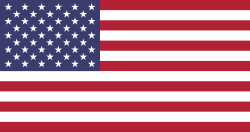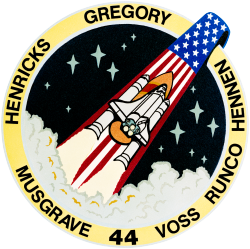James S. Voss
| James Shelton Voss | |
 | |
| NASA Astronaut | |
|---|---|
| Född | 3 mars 1949 Cordova, Alabama |
| Tid i rymden | 202 dygn, 5 timmar, 28 minuter |
| Urvalsgrupp | Astronautgrupp 12 |
| Antal rymdpromenader | 4 st |
| Rymdpromenadtid | 22 timmar, 44 minuter |
| Uppdrag | STS‑44, STS‑53, STS‑69, STS‑101, STS‑102, Expedition 2, STS‑105 |
| Uppdragsemblem | |
James Shelton Voss, född 3 mars 1949 i Cordova, Alabama, är en amerikansk astronaut uttagen i astronautgrupp 12 den 5 juni 1987.
Han och Susan J. Helms innehar världsrekordet i längsta enskilda rymdpromenad 8 timmar och 56 minuter. Rymdpromenaden gjordes den 11 mars 2001.
Rymdfärder
Källor
”Biographical Data” (på engelska) (PDF). NASA. https://www.nasa.gov/wp-content/uploads/2016/01/voss_james_0.pdf?emrc=4d028d. Läst 5 maj 2024.
Media som används på denna webbplats
Emblem of Nasa's STS-53 mission
- Designed by the crewmembers, the STS-53 insignia shows the Space Shuttle Discovery rising to new achievements as it trails the symbol of the Astronaut Office against a backdrop of the American flag. The five stars and three stripes also serve to symbolize the mission designation (STS-53) and America's continuing commitment to world leadership in space. The pentagonal shape of the patch represents the Department of Defense (DOD) and its support of the Space Shuttle Program. The band delineating the flag from space includes the four colors of the military services of the crewmembers. The names of the flight crewmembers are located along the border of the patch. They are Commander David M. Walker, Pilot Robert D. Cabana, Mission Specialist (MS) Guion S. Bluford, MS James S. Voss, and MS Michael R. U. Clifford. Each crewmember contributed to the design of the insignia.
The STS-101 mission patch commemorates the third Space Shuttle flight supporting the assembly of the International Space Station (ISS). This flight's primary tasks are to outfit the ISS and extend its lifetime, and to conduct a spacewalk to install external components in preparation for the docking of the Russian Service Module, Zvezda, and the arrival of the first ISS crew. The Space Shuttle is depicted in an orbit configuration prior to docking with the ISS. The ISS is depicted in the stage of assembly completed for the STS-101 mission, which consists of the United States-built Unity module and the Russian-built Zarya module. The three large stars represent the third ISS mission in the assembly sequence. The elements and colors of the border reflect the flags of the nations represented by the STS-101 crew members, the United States and Russia. The NASA insignia design for Shuttle flights is reserved for use by the astronauts and for other official use as the NASA Administrator may authorize. Public availability has been approved only in the form of illustrations by the various news media. When and if there is any change in this policy, which is not anticipated, it will be publicly announced.
The STS-105 crew patch symbolizes the exchange of the Expedition Two and Expedition Three crews aboard the International Space Station. The three gold stars near the ascending Orbiter represent the U.S. commanded Expedition Three crew as they journey into space, while the two gold stars near the descending Orbiter represent the Russian commanded Expedition Two crew and their return to Earth. The plumes of each Orbiter represent the flags of the United States and Russia and symbolize the close cooperation between the two countries. The Astronaut Office symbol, a star with three rays of light, depicts the unbroken link between Earth and the newest and brightest star on the horizon, the International Space Station (ISS). The ascending and descending Orbiters form a circle that represents both the crew rotation and the continuous presence in space aboard the ISS. The names of the four astronauts who will crew Discovery are shown along the border of the patch. The names of the Expedition Three and Expedition Two crews are shown on the chevron at the bottom of the patch. The NASA insignia design for Shuttle flights is reserved for use by the astronauts and for other official use as the NASA Administrator may authorize. Public availability has been approved only in the form of illustrations by the various news media. When and if there is any change in this policy, which we do not anticipate, it will be publicly announced.
Astronaut James S. Voss will ride aboard Discovery to serve on the Expedition Two crew on the International Space Station (ISS)
STS-44 Mission Insignia
The STS-102 crew insignia depicts the International Space Station as it looked when Space Shuttle Discovery was docked. Visible elements include the P6 and Z1 trusses, solar arrays from the Russian segment, 2 Pressurized Mating Adapters, and the Multi Purpose Logistics Module that was temporarily attached to the underside of the Unity Node. The numbers "102" represent the mission tail number. The red, white, and blue ribbons surrounding the space station represent that this is a crew rotation flight. The colors represent the nationalities of the crewmembers (Russian and American). Underneath the ribbons are the flags of the three nations who are the major contributors to the mission (from left to right: Russia, United States, Italy). The names of the 4 permanent crewmembers are displayed in gold around the top of the emblem. Attached to the bottom are six names depicting the six rotating crewmembers (Expedition 2 on top and Expedition 1 on bottom).
STS-69 Mission Insignia
ISS Expedition 2 insignia.
The International Space Station Expedition Two patch depicts the Space Station as it appears during the time the second crew will be on board. The Station flying over the Earth represents the overall reason for having a space station: to benefit the world through scientific research and international cooperation in space. The number 2 is for the second expedition and is enclosed in the Cyrillic MKS and Latin ISS which are the respective Russian and English abbreviations for the International Space Station. The United States and Russian flags show the nationalities of the crew indicating the joint nature of the program. When asked about the stars in the background, a crew spokesman said they "...represent the thousands of space workers throughout the ISS partnership who have contributed to the successful construction of our International Space Station."








